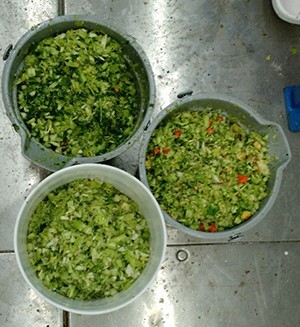
UC Energy Sustainability Research Turns Food Waste to Fuel
The
Food and Agriculture Organization of the United Nations
estimates that a third of all the food produced in the world is never consumed, totaling about 1.3 billion tons of waste a year. The United States alone wastes 40% of all food, worth an estimated $165 billion.
This waste decays in landfills and, without oxygen present, emits methane, which is a more potent greenhouse gas than carbon dioxide. Consequently, food waste creates an overwhelming 3.3 billion tons of greenhouse gases annually and US greenhouse gas emissions account for
19% of the worlds total emissions
, second only to China.
This alarming figure led UC
College of Engineering and Applied Science
(CEAS) researchers to investigate alternatives to landfilling organic wastes. In October 2013, environmental engineering colleagues from the
CEAS Department of Biomedical, Chemical, and Environmental Engineering
, Timothy C. Keener, PhD, and Drew C. McAvoy, PhDalong with fellow faculty members Pablo Campo-Moreno, PhD, San-Mou Jeng, PhD, and George Sorial, PhDproposed an innovative
titled
A Pilot Study to Produce Bioenergy and Fertilizer from UCs Food Waste.
The proposal to convert food waste into gaseous fuels, solid fuels, biodiesel and other products was accepted and today, the study flourishes under the direction of Keener and McAvoy. In October 2014, the team launched a pilot plant that has diverted 660 pounds of food waste generated from UC's Center Court Dining Center for research.

algae
The researchers have since developed a breakthrough synergistic technology that uses
to turn nutrient-rich organic materials into fuel (biogas), fertilizer, or soil conditioner, while using the carbon dioxide fraction of the biogas to grow algae. Simultaneously, lipid oils in the algae are also extracted and converted to biodiesel.
This novel process, which essentially integrates algae production with anaerobic digestion, allows researchers to almost completely utilize the carbon found in food waste in a renewable manner.
McAvoy explains, The anaerobic digestion of food waste coupled with algae production seems to be an attractive alternative for not only reducing greenhouse gas emissions, but also for the production of renewable energy.

Equipment used to promote the growth of algae.
The safe, effective production of plentiful biofuels provides a sustainable source of liquid, solid and gaseous fuels which will minimize or, hopefully, eliminate the use of fossil fuels. In turn, this will curtail or reduce the atmospheric concentration of greenhouse gases. The process would also reduce the release the hundreds of millions of tons of methane and convert millions of tons of carbon dioxide gas into biofuel.
Keener and McAvoy recently presented their research results related to their Renewable Energy Grant, and were well-received by colleagues. They are currently forming a partnership with
, and hope to eventually develop a long range plan with the
to promote the development of a central facility.
Keener says, There is a critical need to optimize the unit operations involved in the mass production of microalgae if this potential biofuel source were to become a reality, making a central facility an absolute necessity moving forward.
It is evident that energy sustainability is the key to properly managing the worlds greenhouse gas emissions. With the help of these CEAS researchers, we are one step closer to improving our environment, and therefore, our quality of life.
More UC Earth Day News
UC is Highlighted Among the Princeton Reviews Green Colleges
UC Off Coal, Thanks to Fuel Pellets
UC Dining, Aramark Offer Eggs from Cage-Free Hens
Thanks to Energy-Saving Efforts, UC Earns Most Duke Energy Rebates
UC Becomes First American Public University to Sell Green Bonds
Additional Contacts
Related Stories
Golden Reunion a perfect opportunity to contemplate, celebrate...
March 14, 2025
We’re all familiar with one of time’s odd characteristics: Something may have happened ages ago, but it can feel like only yesterday. Over many years, things change a lot, or maybe not at all. This feeling is occurring now within the newest members of the UC Alumni Association’s Golden Bearcats Society, which honors those who have reached the half-century mark as University of Cincinnati graduates.
Biomedical engineer studying blunt and blast brain injuries
March 11, 2025
Olga Liaudanskaya, assistant professor of biomedical engineering at the University of Cincinnati, always dreamed of being a scientist. After finishing her graduate degree in materials science and engineering in Italy, she came to the United States for her postdoctoral program, where her research focused on the brain. This led her to a faculty position at UC’s College of Engineering and Applied Science. Recently, she was awarded funding from the Department of Defense for a project on the molecular mechanisms triggered by blunt and blast brain injuries.
Revolutionary Redesign: Biomedical Engineering Student Enhances...
March 10, 2025
Biomedical student Aidan Saylor enhances USAF anthropometry tools, boosting precision and reliability for military readiness.
